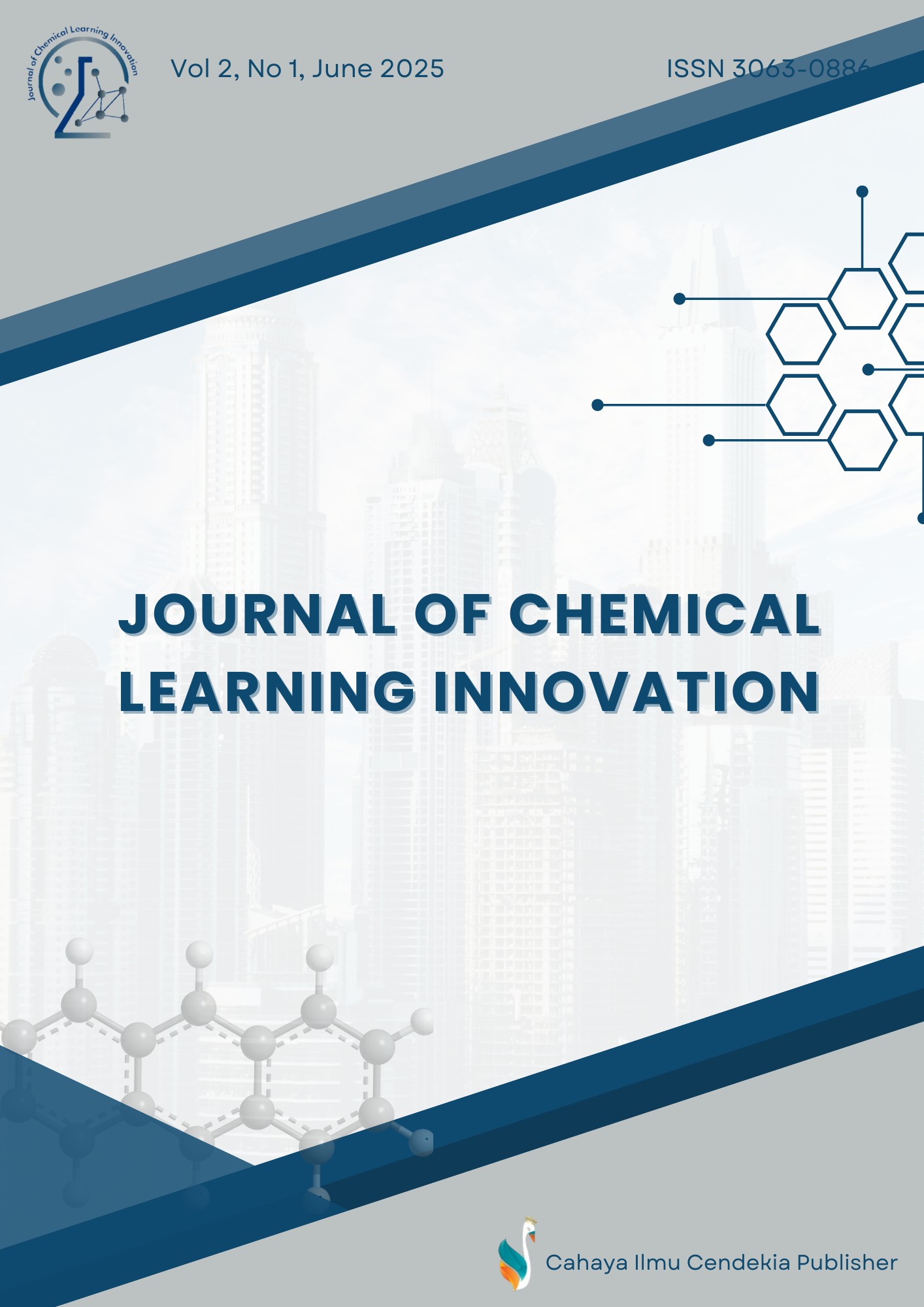Decoding Misconceptions in Thermochemistry: Insights from the Four-Tier Diagnostic Test
Abstract
Purpose of the study: The purpose of this study was to determine whether or not there were student misconceptions and their causes, as well as to determine the percentage of student misconceptions on thermochemistry material measured using the Four-Tier Diagnostic Test Instrument.
Methodology: This research is a descriptive study where the sample in this study was taken using purposive sampling technique. The subjects in this study were students of grade XI and XII of State Islamic High School 1 Pekanbaru. Data collection techniques used in this study were the Four-Tier Diagnostic Test, observation, interviews and documentation.
Main Findings: The study revealed 4% of grade XI and 13% of grade XII students had misconceptions in thermochemistry. Misconceptions were higher in grade XII for basic concepts (19.7%) and reaction types (13.4%), while grade XI struggled more with enthalpy calculations (6.3%). Understanding remained limited across key concepts.
Novelty/Originality of this study: It can help increase teachers' insight in the teaching and learning process, so that teachers are more aware of the explanation of the material that sometimes makes students wrong and experience misconceptions. In addition, teachers can also provide follow-up to students if misconceptions occur.
References
K. H. D. Tang, “Student-centered Approach in Teaching and Learning: What Does It Really Mean?,” Acta Pedagog. Asiana, vol. 2, no. 2, pp. 72–83, 2023, doi: 10.53623/apga.v2i2.218.
D. A. Tholibon et al., “The factors of students’ involvement on student-centered learning method,” Int. J. Eval. Res. Educ., vol. 11, no. 4, pp. 1637–1646, 2022, doi: 10.11591/ijere.v11i4.22314.
A. Windasari, B. Syefrinando, V. Wiliyanti, H. Komikesari, and Yuberti, “The influence of the blended learning model on students’ concept understanding ability viewed from self-confidence,” in AIP Conference Proceedings, 2024, p. 020013. doi: 10.1063/5.0206001.
A. Saleem, H. Kausar, and F. Deeba, “Social Constructivism: A New Paradigm in Teaching and Learning Environment,” Perenn. J. Hist., vol. 2, no. 2, pp. 403–421, 2021, doi: 10.52700/pjh.v2i2.86.
G. Resbiantoro, R. Setiani, and Dwikoranto, “A Review of Misconception in Physics: The Diagnosis, Causes, and Remediation,” J. Turkish Sci. Educ., vol. 19, no. 2, pp. 403–427, 2022, doi: 10.36681/tused.2022.128.
T. Tukiyo, M. Efendi, E. M. Solissa, I. Yuniwati, and S. A. Pranajaya, “The Development of a Two-Tier Diagnostic Test to Detect Student’s Misconceptions In Learning Process,” Mudir J. Manaj. Pendidik., vol. 5, no. 1, pp. 92–96, 2023.
K. Vojíř and M. Rusek, “Preferred chemistry curriculum perspective: Teachers’ perception of lower-secondary school textbooks,” J. Balt. Sci. Educ., vol. 20, no. 2, pp. 316–331, 2021, doi: 10.33225/jbse/21.20.316.
A. Fauzi, A. M. Rosyida, M. Rohma, and D. Khoiroh, “The difficulty index of biology topics in Indonesian Senior High School: Biology undergraduate students’ perspectives,” JPBI (Jurnal Pendidik. Biol. Indones., vol. 7, no. 2, pp. 149–158, 2021, doi: 10.22219/jpbi.v7i2.16538.
A. J. Dood and F. M. Watts, “Students’ Strategies, Struggles, and Successes with Mechanism Problem Solving in Organic Chemistry: A Scoping Review of the Research Literature,” J. Chem. Educ., vol. 100, no. 1, pp. 53–68, 2023, doi: 10.1021/acs.jchemed.2c00572.
Q. Liu, J. Ma, S. Yu, Q. Wang, and S. Xu, “Effects of an Augmented Reality-Based Chemistry Experiential Application on Student Knowledge Gains, Learning Motivation, and Technology Perception,” J. Sci. Educ. Technol., vol. 32, no. 2, pp. 153–167, 2023, doi: 10.1007/s10956-022-10014-z.
S. Aziz and M. Akram, “Diagnosis of Misconceptions in Biology Part of General Science Book: a Case Study of Primary School Students,” Pakistan J. Soc. Res., vol. 04, no. 04, pp. 800–808, 2022, doi: 10.52567/pjsr.v4i04.894.
S. Gul, “5th-grade Students’ Misunderstandings and Misconceptions about Fungi,” Mimb. Sekol. Dasar, vol. 8, no. 2, pp. 179–204, 2021, doi: 10.53400/mimbar-sd.v8i2.33033.
K. Schulman and M. Demantowsky, “Teacher students’ beliefs about and strategies for dealing with students’ misconceptions,” J. Res. Didact. Geogr., vol. 2, no. 11, pp. 15–34, 2022, [Online]. Available: http://scioteca.caf.com/bitstream/handle/123456789/1091/RED2017-Eng-8ene.pdf?sequence=12&isAllowed=y%0Ahttp://dx.doi.org/10.1016/j.regsciurbeco.2008.06.005%0Ahttps://www.researchgate.net/publication/305320484_SISTEM_PEMBETUNGAN_TERPUSAT_STRATEGI_MELESTARI
H. D. Assem, L. Nartey, E. Appiah, and J. K. Aidoo, “A Review of Students’ Academic Performance in Physics: Attitude, Instructional Methods, Misconceptions and Teachers Qualification,” Eur. J. Educ. Pedagog., vol. 4, no. 1, pp. 84–92, 2023, doi: 10.24018/ejedu.2023.4.1.551.
D. Miedema, E. Aivaloglou, and G. Fletcher, “Identifying SQL Misconceptions of Novices: Findings from a Think-Aloud Study,” ACM Inroads, vol. 13, no. 1, pp. 52–65, 2022, doi: 10.1145/3514214.
M. Viscaino, J. T. Bustos, P. Muñoz, C. A. Cheein, and F. A. Cheein, “Artificial intelligence for the early detection of colorectal cancer: A comprehensive review of its advantages and misconceptions,” World J. Gastroenterol., vol. 27, no. 38, pp. 6399–6414, 2021, doi: 10.3748/wjg.v27.i38.6399.
K. T. Kotsis, “Correcting Students’ Misconceptions in Physics Using Experiments Designed by ChatGPT,” Eur. J. Contemp. Educ. E-Learning, vol. 2, no. 2, pp. 83–100, 2024, doi: 10.59324/ejceel.2024.2(2).07.
A. R. Suparman, E. Rohaeti, and S. Wening, “Student Misconception In Chemistry: A Systematic Literature Review,” Pegem J. Educ. Instr., vol. 14, no. 2, pp. 238–252, 2024, doi: 10.47750/pegegog.14.02.28.
Y. Rahmawati, O. Hartanto, I. Falani, and D. Iriyadi, “Journal of Technology and Science Education STUDENTS ’ CONCEPTUAL UNDERSTANDING IN CHEMISTRY,” J. Technol. Sci. Educ., vol. 12, no. 2, pp. 303–326, 2022.
J. Jusniar, E. Effendy, E. Budiasih, and S. Sutrisno, “Eliminating Misconceptions on Reaction Rate to Enhance Conceptual Understanding of Chemical Equilibrium Using EMBE-R Strategy,” Int. J. Instr., vol. 14, no. 1, pp. 85–104, 2020, doi: 10.29333/IJI.2021.1416A.
S. Soeharto and B. Csapó, “Evaluating item difficulty patterns for assessing student misconceptions in science across physics, chemistry, and biology concepts,” Heliyon, vol. 7, no. 11, p. e08352, Nov. 2021, doi: 10.1016/j.heliyon.2021.e08352.
R. Rafika and S. Syuhendri, “Students’ misconceptions on rotational and rolling motions,” J. Phys. Conf. Ser., vol. 1816, no. 1, pp. 1–7, 2021, doi: 10.1088/1742-6596/1816/1/012016.
M. T. Ali, A. R. Woldu, and A. G. Yohannes, “High School Students’ Learning Difficulties in Electrochemistry: a Mini-Review,” African J. Chem. Educ., vol. 2022, no. 2, p. 12, 2022.
E. Taslidere and B. Yıldırım, “Effect of Conceptual Change–Oriented Instruction on Students’ Conceptual Understanding and Attitudes Towards Simple Electricity,” Int. J. Sci. Math. Educ., vol. 21, no. 5, pp. 1567–1589, Jun. 2023, doi: 10.1007/s10763-022-10319-w.
M. McAfee and B. Hoffman, “The Morass of Misconceptions: How Unjustified Beliefs Influence Pedagogy and Learning,” Int. J. Scholarsh. Teach. Learn., vol. 15, no. 1, pp. 1–16, 2021, doi: 10.20429/ijsotl.2021.150104.
F. Mufit, Festiyed, A. Fauzan, and Lufri, “The Effect of Cognitive Conflict-Based Learning (CCBL) Model on Remediation of Misconceptions,” J. Turkish Sci. Educ., vol. 20, no. 1, pp. 26–49, 2023, doi: 10.36681/tused.2023.003.
M. A. Martawijaya, S. Rahmadhanningsih, A. Swandi, M. Hasyim, and E. H. Sujiono, “the Effect of Applying the Ethno-Stem-Project-Based Learning Model on Students’ Higher-Order Thinking Skill and Misconception of Physics Topics Related To Lake Tempe, Indonesia,” J. Pendidik. IPA Indones., vol. 12, no. 1, pp. 1–13, 2023, doi: 10.15294/jpii.v12i1.38703.
C. Menz, B. Spinath, and E. Seifried, “Misconceptions die hard: prevalence and reduction of wrong beliefs in topics from educational psychology among preservice teachers,” Eur. J. Psychol. Educ., vol. 36, no. 2, pp. 477–494, 2021, doi: 10.1007/s10212-020-00474-5.
S. Pieschl, J. Budd, E. Thomm, and J. Archer, “Effects of Raising Student Teachers’ Metacognitive Awareness of Their Educational Psychological Misconceptions,” Psychol. Learn. Teach., vol. 20, no. 2, pp. 214–235, 2021, doi: 10.1177/1475725721996223.
M. Mohzana, I. Israwaty, S. Cindy Sandra Lumingkewas, T. Abdul Tahir, and A. Ilham Arief, “The Effectiveness Analysis of Android Based E-Diagnostic Test Development Program to Identify Level of Student’s Misconception,” J. Educ., vol. 6, no. 1, pp. 1363–1368, 2023.
G.-J. Hwang and Y.-F. Tu, “Roles and Research Trends of Artificial Intelligence in Mathematics Education: A Bibliometric Mapping Analysis and Systematic Review,” Mathematics, vol. 9, no. 584, pp. 1–19, 2021, doi: 10.1109/ICCMST54943.2021.00050.
L. Tomme et al., “Machine learning applications for thermochemical and kinetic property prediction,” Rev. Chem. Eng., vol. 41, no. 4, pp. 419–449, 2024, doi: 10.1515/revce-2024-0027.
A. Kur, J. Darkwa, J. Calautit, R. Boukhanouf, and M. Worall, “Solid–Gas Thermochemical Energy Storage Materials and Reactors for Low to High-Temperature Applications: A Concise Review,” Energies, vol. 16, no. 2, pp. 1–35, 2023, doi: 10.3390/en16020756.
L. S. Ningrum, A. Drastisianti, H. Setiowati, and R. Pratiwi, “Effectiveness of Cognitive Conflict-Based Chemistry Learning in Reducing Students’ Misconceptions of Acid-Base Materials,” J. Penelit. Pendidik. IPA, vol. 8, no. 4, pp. 2425–2429, 2022, doi: 10.29303/jppipa.v8i4.2092.
F. Aydin-Guc and D. Aygun, “Errors and Misconceptions Of Eighth-Grade Students Regarding Operations With Algebraic Expressions,” Int. Online J. Educ. Teach., vol. 8, no. 2, pp. 1106–1126, 2021, [Online]. Available: https://orcid.org/0000-0002-3922-017X
S. Anwar, O. Sumarna, and A. Mulyadi, “Feasibility Analysis of Thermochemistry Senior High School Chemistry Textbook Based on Criteria of Four Steps Teaching Material Development Method,” J. Penelit. Pendidik. IPA, vol. 9, no. 3, pp. 1394–1401, 2023, doi: 10.29303/jppipa.v9i3.2770.
S. Supasorn, K. Wuttisela, A. Moonsarn, P. Khajornklin, P. Jarujamrus, and S. Chairam, “Grade-11 Students’ Conceptual Understanding of Chemical Reaction Rate From Learning By Using the Small-Scale Experiments,” J. Pendidik. IPA Indones., vol. 11, no. 3, pp. 433–448, 2022, doi: 10.15294/jpii.v11i3.36535.
I. Irfandi, R. Murwindra, D. P. Musdansi, W. A. N, and C. Hanri, “Identification and Analysis of Students’ Misconceptions Using Three-Tier Multiple Choice Diagnostic Instruments on Thermochemistry Topic,” IJECA (International J. Educ. Curric. Appl., vol. 5, no. 3, p. 306, 2022, doi: 10.31764/ijeca.v5i3.11613.
M. H. A. Shiddiqi, V. D. Arthamena, M. Ayyubi, A. J. Manarisip, and N. Aznam, “Systematic Literature Review: Analysis of Misconception Problems and Diagnostic Instruments for Learning Chemistry,” J. Penelit. Pendidik. IPA, vol. 10, no. 4, pp. 168–179, 2024, doi: 10.29303/jppipa.v10i4.5189.
F. Nyimbili and L. Nyimbili, “Types of purposive sampling techniques with their examples and application in qualitative research studies,” Br. J. Multidiscip. Adv. Stud., vol. 5, no. 1, pp. 90–99, 2024.
M. Ahmad and S. Wilkins, “Purposive sampling in qualitative research: a framework for the entire journey,” Qual. Quant., pp. 1–19, 2024, doi: 10.1007/s11135-024-02022-5.
Copyright (c) 2025 Widya Novita, Eka Winda

This work is licensed under a Creative Commons Attribution 4.0 International License.
Authors who publish with this journal agree to the following terms:
- Authors retain copyright and acknowledge that the Journal of Chemical Learning Innovation is the first publisher licensed under a Creative Commons Attribution 4.0 International License.
- Authors are able to enter into separate, additional contractual arrangements for the non-exclusive distribution of the journal's published version of the work (e.g., post it to an institutional repository or publish it in a book), with an acknowledgment of its initial publication in this journal.
- Authors are permitted and encouraged to post their work online (e.g., in institutional repositories or on their website) prior to and during the submission process, as it can lead to productive exchanges and earlier and greater citation of published work.





.png)
.png)










